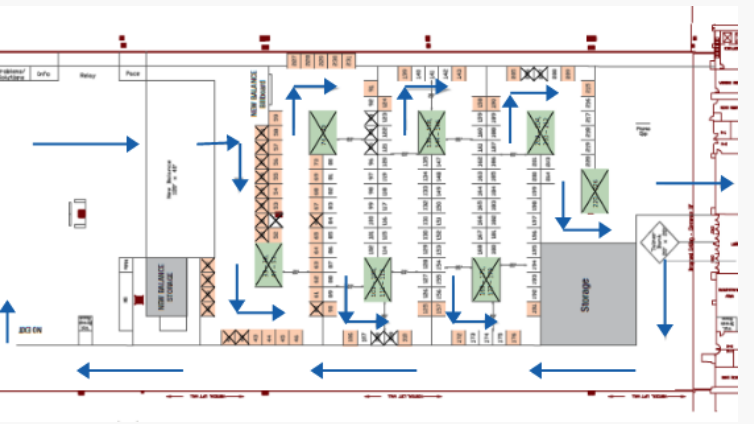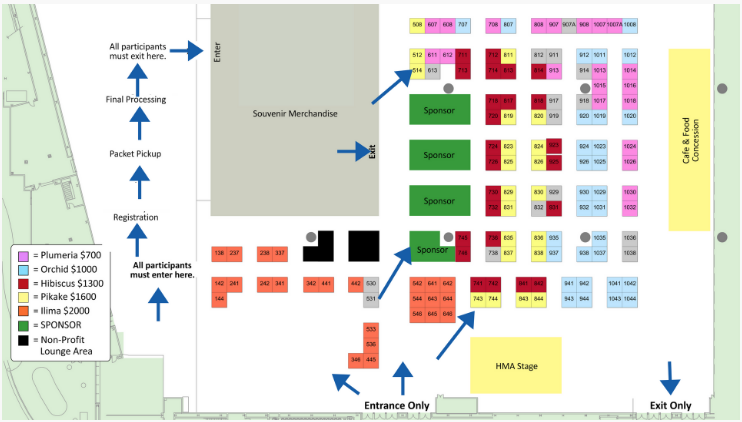One of the most important aspects of producing events is developing sponsorship deals. They are the lifeblood of an expo, and a major source of cash flow for the event budget as a whole, making them critical. In addition to developing sponsorship deals, there are several technical aspects of expos that must be examined.
We recently had the pleasure of interviewing Dennis McWhorter, Director of Event Sales for National Running Center, who has been managing booths at expos nationwide since 1984. The company was one of the first to put their “store on wheels”, selling running merchandise at expos. We leaned on Dennis’ 34 years in the business to shed light on some best practices in expo design and management. We also incorporated knowledge from our co-founders who have a combined 20 years of experience of booking and managing activations at all types of live events. Below are tips on how to design a successful expo.
Designing an Optimized Floor Plan
The layout and foot traffic flow of an expo is extremely important to exhibitor success. Choosing a floor plan that funnels attendees through the the majority of the expo, will ensure every exhibitor ample opportunity to connect with customers. Here are four of the most popular designs we’ve come across. Each have their pros and cons, with some of each listed below.
Snake:

Pros: The Snake design funnels attendees past every booth after picking up their bibs, when they’re in a browsing mindset. This layout protects all exhibitors, making sure that they all see the advertised amount of foot traffic. This strategy can work for expos of any size.
Cons: For attendees in a rush there is no quick exit option, and some may feel a bit like herded cattle depending on how many rows of exhibitors they are guided through.
Free Flowing:

Pros: With a free flowing floor plan, attendees have the ability to migrate throughout the expo at their own speed and exit whenever they’d like. This layout is good for destination races where participants are looking to get the most out of their full race experience and scour the expo for hidden gems.
Cons: Because attendees can migrate and exit whenever they’d like, it increases the likelihood that they will miss many of the peripheral booths.
Down & Back:

Pros: Attendees enter and exit through the same access point in this layout, and cross the length of the floor twice in the process of picking up completing packet pickup. This gives them a certain amount of freedom but also gives ample amount of opportunity to engage with many exhibitors. This is ideal for a floor plan with 60 exhibitors or less.
Cons: Attendees may feel as though they are being herded, and forced to walk through the expo twice rather than being able to exit after they pick up their t-shirts and bibs.
Hook:

Pros: This layout protects the sponsors who have paid the most to be there. Attendees then have ability to exit whenever, but still pass through a large portion of the floor on the way out. It’s a blend of attendee freedom and exhibitor consideration.
Cons: While your title sponsor is protected and will see a lot of foot traffic, the exhibitors that are on the outskirts of the floor plan have more of a chance of landing in dead space if attendees make a beeline the exit.
Expo Hours
It can be hard choosing the best length for an expo. If there are too many hours the floor is dead for large portions, and if there are too few, the floor is packed and potential sales are missed. Here are a few thoughts to help optimize your expo schedule, that will ultimately maximize your race expos value.
“Some people have too many hours… somewhere between 3,000-5,000 runners they probably only need a one day show with a 6-8hr period,” said McWhorter. Mid-sized marathons (5,000-10,000 attendees) might work best with an expo open for 1 ½ days. Larger events (10,000+) might require a full 2 days or longer. “I don’t have any magic numbers: NY is charging $7,000 a booth and they have Thursday, Friday, and Saturday it just keeps ramping up and getting busier… it’d be nice to spread it out (over a fourth day),” said McWhorter. While these ranges are not set in stone, they are some good general guidelines to consider when setting expo operating hours.
Organizers are often reluctant to reduce floor hours in fear that exhibitors will shy away from shorter total hours. However, if exhibitors can be assured that there will be the same amount of attendees, with a healthier flow of traffic, they’ll understand that the show is maximizing the best use of their time. Additional, if the shortened hours result in significantly lower venue costs (for example, by shaving off a prep day) it could enable the event to achieve the same or better profit margins, even with a lower base booth fee.
Planning for the busiest times of your expo is also important. Having an uncramped layout, with wide enough aisles, and enough volunteers is critical to being able to handle crowd surges.

Best Practices for Exhibitor Support
Supporting exhibitors is often overlooked. Providing assistance from the moment they sign up, until load- out is an easy way to maximize your expos value. Here are a couple ways to provide your exhibitors with support throughout the production process.
When it comes to paperwork, guidelines, and other logistics, organizers should distribute these as far as three months in advance. Giving exhibitors more than enough time to fill them out and send back to you. Not to mention, it decreases the chance that you will have to chase them down at the last minute for missing paperwork.
If you have the manpower to help exhibitors unload and assist with equipment, it can help set-up run smoothly, relieve time constraints and reduce organizer and exhibitor stress. If you don’t have the numbers to provide volunteers there are other ways to lend a hand. “Even just providing handcarts and stuff like that it helps. Exhibitors are suppose to provide them themselves, but it does make it faster when the expos provide handcarts that can carry more weight or whatever it is,” said McWhorter.
Communication is Key!
Last but definitely not least, communicate well with your exhibitors! In the same way you wouldn’t throw a ton of requirements at attendees, you don’t want to surprise exhibitors with last minute deliverables.
It is hard to control surprises and setbacks throughout the production process, but you can always control the level of transparency you have with exhibitors. Including; keeping them informed about paperwork requirement due dates, providing them with a list of everything that will be supplied to them at the expo, and letting them know if there are any time restrictions for break down.“There are some situations where an event is renting a hall and after the specific amount of time it’s a thousand dollars an hour, so they don’t give the vendors a ton of time to break down. But when it is communicated clearly that they only have a certain amount of time to break down then exhibitors can plan for that,” said, McWhorter.
Responsive communication with your exhibitors is also important. Meaning, when they reach out to you with questions or concerns, you are getting back to them as fast as possible. While free flowing communication can be time consuming, it is a great way to maximize your race expos value.
Conclusion
Each of these tips are an important part of enhancing the worth of your expo for exhibitors, and ultimately your event’s success both now and for future years. It is important to incorporate these aspects in every stage of the event lifecycle, from pre-production planning up through day-of-expo in order to maximize your race expos value.





